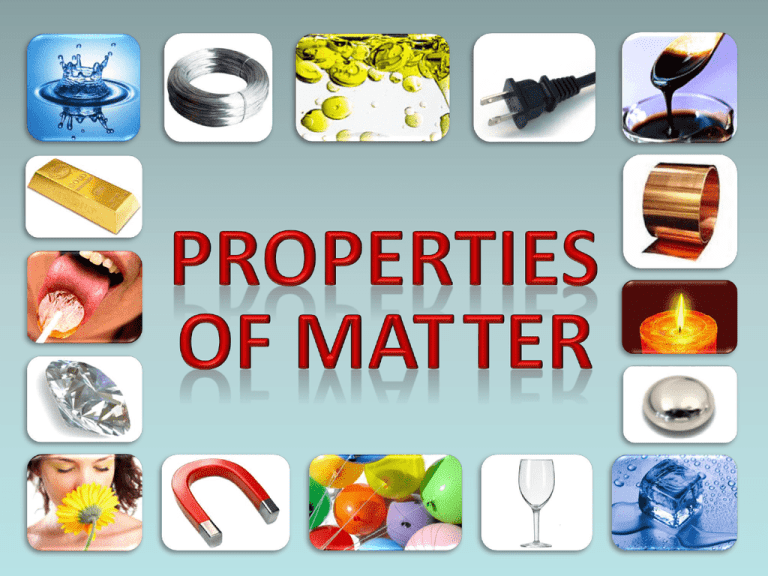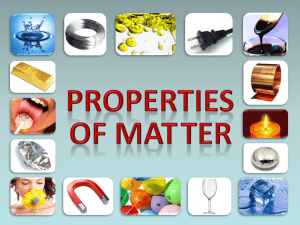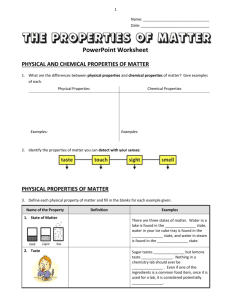
INTRODUCTION TO PROPERTIES
PHYSICAL PROPERTIES VS. CHEMICAL PROPERTIES
• A property of a substance
that can be observed or
changing
measured without
______________
the chemical identity of the
substance.
e.g. color, state of matter
• A property of a substance
it reacts
that describes how
___________
to other substances and
_________________
changes
its chemical
______ as a result.
identity
e.g. combustibility
Which properties can you detect with only your senses?
taste
touch
• taste
• texture
• hardness
sight
smell
• color
• odor
• clarity
• texture
• luster/shininess
RECALL: A PHYSICAL PROPERTY of a substance can be
without changing the chemical
observed or measured _______________
identity of the substance.
STATE OF MATTER
The property of a substance that determines
liquid , ____
solid or ___.
gas
whether or not it is a _____
There are three states of matter. Water in a lake is found
liquid
in the _____________
state, water in your ice cube tray is
solid
found in the _____________
state, and water in steam is
found in the _____________
gas
state.
TASTE
The property of a substance that describes how it affects
taste receptors otherwise known as _________.
taste buds
the _____________
sweet
Sugar tastes _____________
and lemons taste
sour
_____________.
Nothing in a chemistry lab should
tasted
ever be _____________.
Even if one of the
ingredients is a common food item, once it is used for
contaminated
a lab, it is considered potentially _____________.
ODOR
The property of a substance that describes how it affects
olfactory (smell) receptors
the _______________________.
bad
Old dirty gym socks smell _____________
and roses smell
_____________.
Never _____________
anything in a chemistry
good
smell
lab unless instructed to do so. If smelling a substance, the
_____________
hand-waving method should be used to sniff it.
COLOR
The property of a substance that describes how it affects
light sensing receptors in your ___________
eyes / retina when
the ___________________
wavelengths of light.
that substance _______
reflects different ___________
red
A fire truck is _____________
but the sky on a sunny day is
blue
_____________.
The leaves on the trees in the summer are
green
_____________,
but the color of the sun is _____________.
yellow
orange
The color of an orange is _____________!
LUSTER
shiny or
The property of a substance that describes how _____
lustrous it is.
_______
dull
A piece of paper is _____________
because it does not reflect
lustrous / shiny because it
much light, but the chrome on a car is _____________
an eraser
reflects a lot of light. Another dull thing is _______________
and
a spoon
another shiny thing is _____________.
CLARITY
The property of a substance that describes how much
light can pass through it.
____
transparent , meaning that it lets all the
A piece of glass is _____________
translucent because it
light pass through it, maple syrup is _____________
lets some light through it, and mud is _____________
because
opaque
it lets no light pass through it.
TEXTURE
The property of a substance that describes how the
surface
______ of a substance feels
____.
smooth
The surface of a bowl feels _____________
but the surface
of the cement sidewalk feels _____________.
The fur of a
rough
cat feels _____________
soft/fluffy . The surface of an eraser feels
rough/tacky .
_____________
HARDNESS
The property of a substance that describes how
difficult it is to scratch
______ its surface.
diamond
On Mohs hardness scale of minerals, a _____________
is the
hardest known substance on Earth with a hardness level of
10
_____________.
An emerald is also hard but it has a hardness
7.5
level of _____________
.
SOLUBILITY
The property of a substance that describes how easily
dissolves when mixed with another substance.
it ________
Water and vinegar mix together completely and therefore,
soluble
soluble
vinegar is _____________
in water. Salt is also _____________
in water because it will dissolve completely in water. Neither
oil nor sand will dissolve in water, and that is why they are
insoluble
considered _____________
in water.
VISCOSITY
The property of a substance that describes how
pour or how _____
thick it is.
easily it can ____
less
Water is _____________
viscous than oil, and that is why it
pours out of its container more easily than oil does. Ketchup
more
is _____________
viscous than oil, and that is why it’s
harder
_____________
for it to pour out of its container.
MALLEABILITY
The property of a substance that describes its
bent or hammered
sheet
ability be _____
_________ into a thin
________
breaking
without ________.
Aluminum is very malleable and that is why we use it to
_____________
make foil to wrap our food. Other substances, like glass, are
not
_____________
malleable because it would break instead of
not malleable , while copper is
change shape. Wood is _____________
malleable
_____________.
DUCTILITY
The property of a substance that describes its ability
thin wire without ________.
breaking
to be drawn into a ________
gold
copper
Many metals like _____________
and _____________
can
easily be drawn into a thin wire. Substances like water and
ductile
cement are not _____________
.
DENSITY
The property of a substance
that describes how much
mass of that substance is
_____
volume of
contained in a _______
space.
less
Rubber is _____________
dense than water and that is why it
more
will float on water. A penny is _____________
dense than water
and that is why it will sink to the bottom of the water. Water in
solid
its _____________
state is less dense than water in its
liquid
_____________
state. That is why ice floats on water.
ELECTRICAL CONDUCTIVITY
The property of a substance that is a measure of
electrical current
its ability to conduct an _______________.
Copper
good
_____________
is a _____________
electrical conductor, and
that is why it is used as the main material for the wiring found
not
in most homes and electronics. Plastic is _____________
a
good conductor of electricity and that is why it is used to
insulate
_____________
electrical wires.
MELTING POINT AND BOILING POINT
The property of a substance that is the
temperature at which it transforms from the
___________
solid state into the liquid
____
_____ state.
The property of a substance that is the
temperature at which it transforms from the
___________
liquid state into the ____
gas state.
_____
0 C and the
The melting point of water is ____
100 C. The melting
boiling point of water is ____
gold
point of _____________
is 1063 C and the
boiling
_____________
point of gold is 2856 C.
CRYSTAL FORM
The property of a substance that describes the
geometrical
shapes that it forms when it makes
________________
solid state.
crystals in its _____
If you look with a high powered microscope, you can observe
that sugar crystals are oblong and slanted at the sides, but the
cube
crystal form of salt is shaped more like a _____________.
MAGNETISM
The property of a substance that describes if it is
magnetic field
attracted to a ____________.
attracted
Some substances like steel are _____________
to a magnet and
magnetic
therefore are considered _____________.
Substances like glass
not
are _____________
attracted to magnets and are called
non-magnetic .
_____________
RECALL: A CHEMICAL PROPERTY of a substance
how it reacts to other substances and how it
describes ___________
changes its chemical identity as a result.
________________________
COMBUSTIBILITY
The property of a substance that describes
fire in the
whether or not it will catch on ___
presence of oxygen
______ and heat
____.
combustible Dry wood is _____________
more
Glass is not _____________.
Fossil
combustible than wet wood. _____________
fuels like coal,
natural gas, and gasoline are all combustible.
REACTIVITY WITH WATER
sodium
The property of a substance that
describes whether or not it is
water
reactive with ______.
water
sodium
Some substances like _____________
are very reactive with
water, and so they have to be stored in a water-free environment.
Even the water vapor in the air can cause a reaction, so these
mineral oil
substances must be stored under _____________.
Quick Assessment
1) A recycling company collects
cans. Some of the cans are
made of aluminum and others
are made of iron. Which
physical property could be
used to separate the cans?
A. Odor
B. Ability to conduct or insulate
C. Solubility
D. Magnetism
2) Which of the following is
not a physical property?
A. Conductor
B. Yellow
C. Water
D. Magnetic
Created by Anh-Thi Tang – Tangstar Science
Copyright © April 2013 Anh-Thi Tang (a.k.a. Tangstar Science)
All rights reserved by author.
This document is for personal classroom use only.
This entire document, or any parts within, may not be
electronically distributed or posted to any website.






